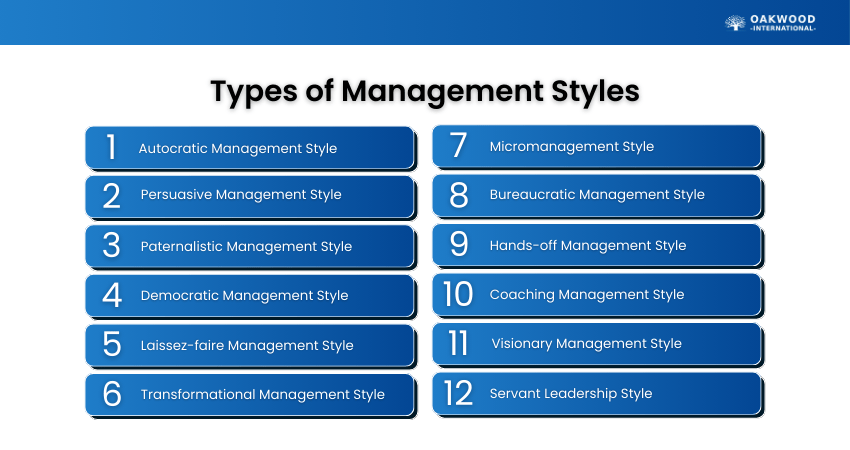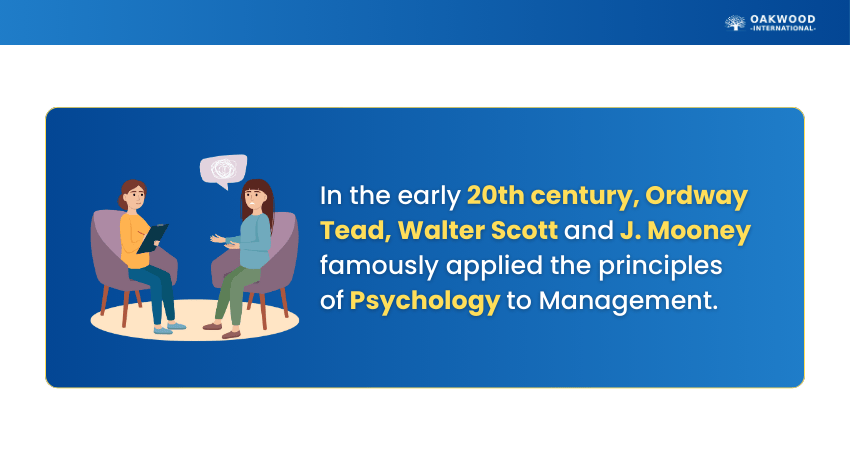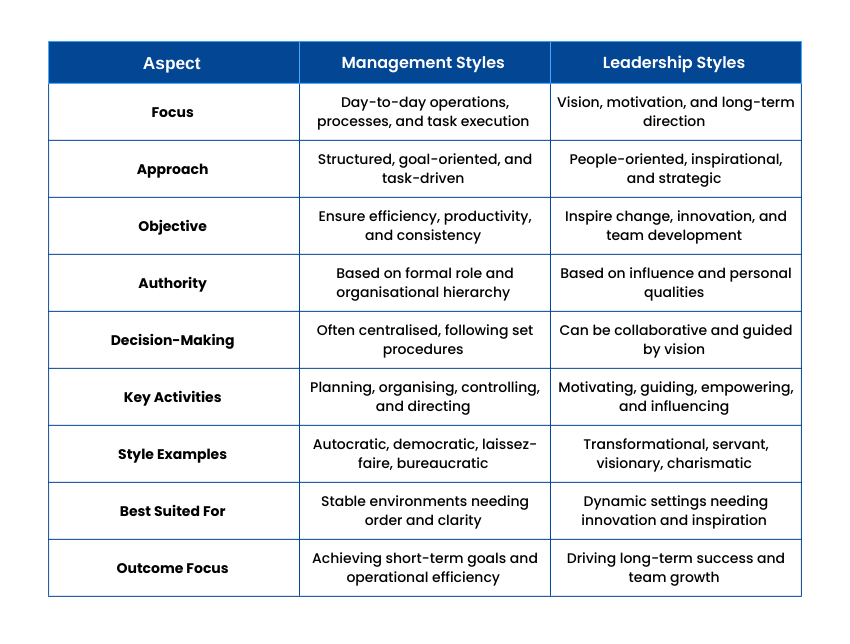Table of Contents


Every manager has a unique way of leading, but the most successful ones know when to adapt. After all, leadership isn’t one-size-fits-all; it’s a dynamic spectrum of strategy, empathy and adaptability. From visionary trailblazers to democratic and diplomatic collaborators, each Management Style shapes team culture and performance in unique ways.
In this blog, you'll get to explore the top 12 Types of Management Styles, decode their strengths and guide yourself on how to perfectly implement them. Whether you're keeping a startup afloat or steering a corporate ship, discover the style that fits your rhythm and inspires your team to thrive. Read on!
Table of Contents
What are Management Styles?
Common Types of Management Styles
How to Implement Effective Management Styles?
Difference Between Management Styles vs Leadership Styles
Conclusion
What are Management Styles?
Management Styles refer to the different ways a manager leads and guides their teams. These styles go a long way in shaping how they make decisions, organise tasks, give rewards, handle discipline, and utilise their authority. Choosing effective Management Styles that match your personality, strengths and weaknesses can help you become a more effective and confident manager.
The best Management Style for you depends on factors such as:
Workplace
Industry
Team Size
Current processes
Team’s personalities
Your own strengths and weaknesses
Different styles suit different situations. Finding what works best takes time, testing and input from across the company.
Common Types of Management Styles
As mentioned above, there’s no single right way to lead a team. The best managers adapt their style based on the situation, goals and people involved. Let's explore the most common styles employed by managers:

1) Autocratic Management Style
The Autocratic Management Style grants the manager complete control as he can make all key decisions without input from the team. The manager sets the goals, assigns tasks and decides the team's focus based solely on their judgment. This top-down approach means the manager leads and the team follows with little room for feedback or collaboration.
Pros:
1) It delivers fast decision-making, since only one person is in charge.
2) It’s useful in urgent or high-pressure situations where accuracy is critical.
Cons:
1) Team members may not share ideas if they feel unheard.
2) It limits creativity in favour of control and efficiency.
Autocratic Management Style is best suited for situations that demand quick action and clear direction, such as emergencies or tightly controlled environments.
2) Persuasive Management Style
The Persuasive Management Style is a form of autocratic leadership, but with a difference. While the manager still makes all the decisions, they take the time to explain the reasons behind them. This helps the team stay informed and understand the thinking behind actions, even if they don’t get to contribute to the final decision.
Pros:
1) It supports learning for newer or less experienced team members.
2) It builds trust by being transparent, even without collaboration.
Cons:
1) Communication is mostly one-way, limiting team feedback.
2) Team members might feel their opinions don’t matter, even if they’re kept informed.
This Management Style is best suited for teams that need strong guidance but are still cultivating their skills and confidence.
Become the mentor every future leader needs. Sign up for our ILM Level 5 Diploma in Effective Coaching and Mentoring and inspire unparalleled growth!
3) Paternalistic Management Style
The Paternalistic Management Style is a caring form of autocratic leadership. The manager makes all the decisions, but they consider the team’s well-being while doing so. Although the approach isn’t truly collaborative, employees share their views and there’s an expectation that leadership will listen, even if not every suggestion is acted upon.
Pros:
1) Decisions are made with the team’s best interests in mind.
2) Employees feel safe to speak up, even if they don’t have decision-making power.
Cons:
1) If trust is lacking, the approach may feel controlling.
2) It can become demotivating in environments without strong leader-employee relationships.
4) Democratic Management Style
The Democratic Management Style, also known as participative leadership, involves the team in decision-making. Everyone is encouraged to share ideas, give feedback, and be part of shaping plans. While the manager still makes the final call, the process is collaborative and open.
This style builds alignment early by linking everyday work with company goals. Managers actively seek team input and adjust plans when needed.
Pros:
1) It helps the team see how their work supports long-term objectives.
2) It builds engagement, trust, and ownership while encouraging better ideas through group input and feedback.
Cons:
1) Collaboration can slow progress if managers are not actively engaged.
2) Conflicts may arise without proper guidance and consistent involvement from leadership.
5) Laissez-faire Management Style
The Laissez-faire Management Style is the most hands-off approach to leadership and management. The name means "let it go" in French, and that’s exactly what these managers do. They give team members full freedom to work as they see fit and only step in when necessary. There are few meetings, minimal check-ins, and guidance is given only when problems pop up.
Pros:
1) It encourages creativity, independence, and self-driven work.
2) It suits highly motivated team members who thrive with minimal supervision.
Cons:
1) Less experienced employees may feel lost without clear structure.
2) Limited feedback and support from managers can weaken collaboration and disconnect work from broader goals.
This Management Style is best suited for skilled, independent individuals who are confident in managing their own tasks without much oversight.

6) Transformational Management Style
The Transformational Management Style is a type of democratic leadership that focuses on big-picture goals, innovation and helping people achieve professional growth. It’s commonly used in fast-paced or creative environments. Transformational leaders set bold goals and motivate their teams to adapt and evolve.
Pros:
1) It’s ideal for driven individuals who are keen to develop their skills.
2) It creates a strong sense of purpose and keeps the team focused on a shared vision.
Cons:
1) High expectations can cause stress or burnout if support is lacking.
2) If the goals seem too ambitious, it may lead to low morale or staff turnover.
This approach is best suited for teams that are proactive towards embracing change and trying new ideas together.
7) Micromanagement Style
Micromanagement is when a manager closely monitors every small detail of an employee’s work. While this can help ensure tasks meet specific standards, it often leads to high stress and low independence. Constant oversight can make employees feel distrusted and frustrated, reducing both morale and productivity.
Pros:
1) It ensures work is completed exactly to the required standards.
2) It allows managers to closely track progress and spot errors quickly.
Cons:
1) Constant supervision creates stress and reduces employee independence.
2) It lowers motivation, trust, and overall team performance.
This approach must be avoided in most situations. It's suitable only when precision is critical, such as in safety-sensitive roles.
8) Bureaucratic Management Style
The Bureaucratic Management Style is all about following rules, procedures, and a clear chain of command. While this approach brings consistency and clarity, it often slows down decision-making and limits creative thinking. Employees may feel constrained by rigid structures, making it difficult to stay engaged or adapt to change.
Pros:
1) It promotes consistency by following well-defined rules.
2) It reduces confusion with clearly assigned roles and responsibilities.
Cons:
1) Strict processes can slow down decision-making.
2) It limits creativity and innovation, which may lower employee engagement.
This approach is best for large, traditional organisations that require structure and control. It’s not ideal for dynamic or fast-changing environments.
Sharpen your leadership and team skills and break every barrier to organisational excellence. Sign up for our ILM Level 2 Certificate in Leadership and Team Skills now!
9) Hands-off Management Style
The Hands-off Management Style, also known as absentee leadership, involves a manager who is rarely present and offers little guidance or support. This lack of involvement often leads to confusion, weak direction and poor team performance. Without active leadership, teams struggle to stay aligned and motivated.
Pros:
1) It gives employees complete freedom to work without interference.
2) Highly independent team members may appreciate the lack of oversight.
Cons:
1) Lack of direction creates confusion and leaves employees feeling unsupported.
2) It reduces team unity, lowers motivation, and harms overall productivity.
This approach is best avoided in all workplace settings because teams need engaged, supportive leadership to perform well and stay motivated.
10) Coaching Management Style
The Coaching Management Style focuses on developing people, not just tracking results. Managers take on a mentor-like role, guiding team members to grow their skills, improve performance, and reach their full potential. They regularly ask questions, give feedback, and help employees reflect on how they work, not just what they achieve.
Pros:
1) It supports professional growth through personal guidance and mentoring.
2) It builds strong relationships and long-term engagement by connecting daily tasks to bigger career goals.
Cons:
1) It requires significant time and consistency, which can be difficult in fast-paced environments.
2) It may feel over-involved for experienced employees who prefer greater independence.
This Management Style is ideal for teams with new hires or individuals taking on new skills and responsibilities.

11) Visionary Management Style
The Visionary Management Style, a form of democratic leadership, focuses on inspiring teams through a clear and meaningful long-term vision rather than managing day-to-day tasks. Visionary leaders motivate by showing the bigger picture where the team is headed and why it matters.
Pros:
1) It encourages creative thinking and fresh problem-solving approaches.
2) It inspires strong commitment to the work and its purpose.
Cons:
1) The inspiration must be authentic because fake enthusiasm won’t resonate.
2) Without regular guidance, some team members may feel uncertain or disconnected.
This approach is best suited for teams working on innovative projects who need motivation and a strong sense of purpose.
12) Servant Leadership Style
Servant Leadership Style focuses on serving others first, empowering team members, and fostering a supportive environment. Leaders prioritise the growth, well-being, and development of their teams, creating a culture of trust, collaboration, and shared purpose.
Pros
1) Employees feel valued and supported, leading to higher morale and productivity.
2) Promotes open communication and teamwork, strengthening relationships and innovation.
Cons
1) Emphasis on consensus and support can delay urgent decisions.
2) Constantly prioritising others' needs may lead to emotional exhaustion for the leader.
This Management Style is ideal for teams that value openness and a leadership style based on guidance and support rather than control.
Inspiring teams and driving results doesn't have to be an uphill battle. Our ILM Level 2 Award in Leadership and Team Skills Course will show you how - Sign up now!
How to Implement Effective Management Styles?
Adopting the right Management Styles is about implementing key practices that support your team and amplify performance. Here’s how to make your management approach more effective:
1) Define Clear Goals and Expectations
Make sure everyone on the team understands what they’re working towards. Set clear, realistic goals and explain how each person’s role contributes to the bigger picture. Remember that clarity builds focus and alignment.
2) Provide Ongoing Training and Development
Help your team grow by offering regular learning opportunities. Whether it's workshops, mentoring or online courses, continuous development keeps skills sharp. It shows your team you’re invested in their progress.
3) Encourage Autonomy and Accountability
Trust your team to make the right decisions and take ownership of their work. Give them the space to do their jobs while holding them accountable for the results. This builds confidence and responsibility.
4) Support Employee Wellbeing
A good manager cares about more than just output. Be mindful of your team’s workload, stress levels, and work-life balance. Offering flexibility and showing empathy go a long way in building loyalty and morale.
5) Maintain Transparent Communication
Keep communication open and honest. Share updates, welcome feedback, and schedule regular check-ins. Clear communication results in more trust and ensures that everyone stays aligned.
Difference Between Management Styles vs Leadership Styles
Here are the key distinctions between Management Styles and leadership styles:

Conclusion
Understanding the different Types of Management Styles gives you the flexibility to lead with purpose, not just routine. Each style has its place, so what matters is knowing when and how to apply it. By aligning your approach with your team’s needs and workplace dynamics, you can boost trust and performance, while growing into a confident and adaptable leader.
Dreaming of unlocking the leader within? Sign up for our ILM Level 2 Training and lead your way to success!


 Back
Back



 Back to Catagories
Back to Catagories





 + 44 7452 122728
+ 44 7452 122728










